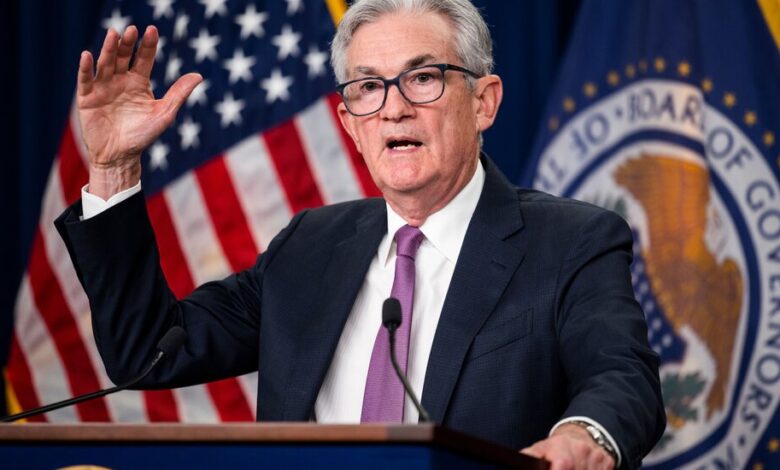Wall Street Is in Limbo as Investors Look to Powell for Guidance

Investors are bracing for Jerome H. Powell, the Federal Reserve chair, to deliver a stern warning that the bank is far from finished in its campaign to slow inflation with higher interest rates.
On Friday, Mr. Powell will speak at the Kansas City Fed’s Economic Policy Symposium in the Jackson Hole resort area of Wyoming, the central bank’s most prominent annual conference. Other Fed officials have recently tried to send the message that even after data on consumer prices showed that inflation eased up in July, the central bank is intent on damping demand by raising borrowing costs, which is normally a bad thing for the stock market.
But for most of the past two months, stocks have rallied. From mid-June to mid-August, the S&P 500 had risen about 17 percent, gains that in part reflected a view in markets that the Fed had pivoted away from its all out war on inflation to a more gentle approach.
Some on Wall Street see Mr. Powell’s address on Friday as an opportunity for him make clear that the Fed is willing to be aggressive, by departing from his usually tempered tone.
“There has been a disconnect between Fed rhetoric and market moves in recent weeks,” said Kristina Hooper, the chief global market strategist at Invesco. “This is the moment when markets are starting to worry that they have got it wrong.”
These concerns have become evident over the past week. The S&P 500 has dropped 3.6 percent in the past three days, including its sharpest daily decline in more than two months. This put a dent in the recent rally, leaving the index down by about 14 for the year.
The shifting outlook is also apparent in other financial markets. Market-based expectations for the amount the Fed will raise interest rates at its meeting next month have recently drifted from predicting a half-point increase to leaning toward a more aggressive three-quarter-point increase.
The yields on 10-year Treasury bonds, which help set lending rates across the globe, have also jumped, alongside rising inflation expectations. This week, the dollar reached a new 20-year peak against a basket of currencies representing the United States’ major trading partners, reflecting the interest-rate outlook.
Against this backdrop, Mr. Powell will take the stage on Friday at the gathering of central bankers and economists from around the world. Held each year at Jackson Hole, the conference is often a venue for making big announcements or floating significant ideas.
Bank of America analysts forecast that the recent shift in the market will give Mr. Powell room to lean hawkish — financial parlance for monetary policy that is restrictive for the economy — and that could send stocks even lower.
Conversely, a more moderate tone from Mr. Powell — as he has delivered before at Jackson Hole — could push stock and bond prices higher.
“Chairman Powell has comforted markets in the past,” said Jonathan Coleman, an equity portfolio manager at Janus Henderson. “I hesitate to predict what will happen in the next couple of days but the market might have a relief rally.”
Such uncertainty extends further out, too, especially over when the central bank’s campaign to tame inflation will end.
Investors are betting on the Fed reversing course and lowering interest rates next year, which stands in contrast to the central bank’s own forecasts.
It suggests that although the short-term expectations of investors and the Fed have come closer together, there remains a longer-term disconnect, with markets implying that the central bank will ease restrictions on the U.S. economy sooner than it has itself communicated.
“There is still this idea that we will see a Fed pivot next year. We don’t think it’s the case,” said Cindy Beaulieu, who leads Conning Asset Management’s investment policy committee. “The Fed’s perception is that they have a battle to fight. We do not think they will back off.”
Understand Inflation and How It Affects You
- Inflation Calculator: How you experience inflation can vary greatly depending on your spending habits. Answer these seven questions to estimate your personal inflation rate.
- Managing Your Finances: With interest rates rising, now is a good time to pay down credit card balances and bolster emergency savings.
- Cost of Living: As food prices rise, eating is becoming increasingly expensive. We took a close look at five New Yorkers’ food and drink habits to see where the effects are most felt.
- A New Playbook: As brands grapple with inflation, they are taking a new approach: being upfront about price increases, hoping that transparency will keep customers loyal.
Greater conviction, one way or the other, could come in September, when Wall Street returns in earnest from summer holidays — low summer trading volumes mean market prices are more easily pushed around by small changes in sentiment.
Fresh data on the labor market is also due early in the month, a new inflation reading coming a few weeks later, and then the pivotal meeting of Fed officials to set interest rates after that.
Mr. Powell has highlighted officials’ intent on being data dependent, meaning the Fed could slow the pace of interest rate increases if inflation slows, while signs of stubborn price rises could compel the central bank to become even more aggressive.
Investors have so far preferred to focus on the more positive potential outcome, even though neither scenario is yet to be fully born out.
Investors will be hanging on Mr. Powell’s words on Friday, looking for hope that the central bank could rein in its inflation-fighting campaign, said Sonal Desai, the chief investment officer for fixed income at Franklin Templeton.
“I am sure they will find it,” she said. “Whatever he actually says.”
